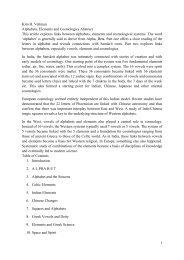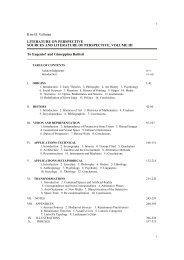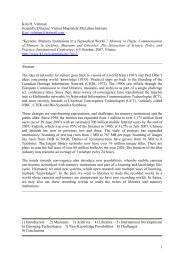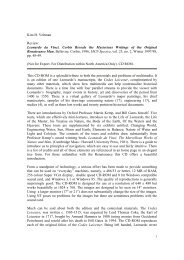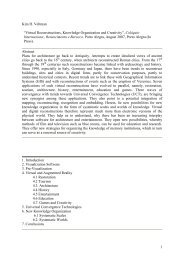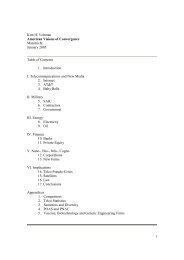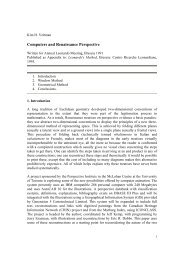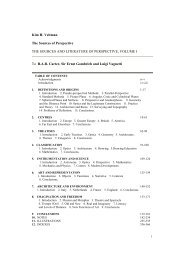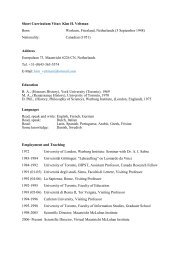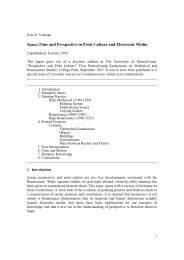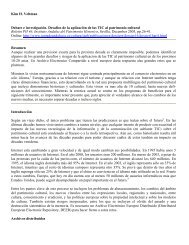1986 Perspective, Anamorphosis And Vision
1986 Perspective, Anamorphosis And Vision
1986 Perspective, Anamorphosis And Vision
Create successful ePaper yourself
Turn your PDF publications into a flip-book with our unique Google optimized e-Paper software.
34 Jean Louis, Sieur de Vaulezard, <strong>Perspective</strong> cilindrique et conique; ou traité des<br />
apparences veues par le moyen des miroirs cilindriques, Paris: J. Jacquin, 1630; ibid.,<br />
Abrégé ou racourcy de la perspective par l'imitation, Paris: chez l'auteur, 1631.<br />
35 Cf. Baltrusaitis, as in note 1 above, pp. 48-51.<br />
36 Jacob Leupold, Theatrum mechanicarum, Supplementum, Leipzig: Authore, pp. 55-57,<br />
Tab. 16,18<br />
37 See, for instance, the title to Hieronymus Rodler or Johann II v. Pfalz-Simmern: Ein<br />
schön nötzlich Büchlin und under-weisung der Kunst des Messens ... Zu nutz allen ...<br />
Malern, Bildhawern ... auch allen ander, so sich der Kunst des Mes-sens (Perspectiva zu<br />
latin gnant) zu brauchen lust haben, Siemeren: inn Verlegung Hieronimi Rodler, 1531.<br />
38 See: H. Schöne, „Die Dioptra des Heron", Jahrbuch des Archäologischen Instituts,<br />
Berlin, Bd. 14, 1899, S. 91-103.<br />
39 C. de Judaeis (i.e. Gerard de Jode), De quadrante geometrico, Norimbergae: Typis<br />
Christophori Lochneri, 1594, p. 47.<br />
40 Leonardo da Vinci, Codex Arundel, London: British Museum, fol. 279-281. These<br />
passages have been analysed in detail elsewhere. Cf. note 22 above.<br />
41 Egnazio Danti, as in note 33 above, p. 45.<br />
42 42 Vaulezard, as in note 34 above.<br />
43 See: Johann Heinrich Lambert, Schriften zur Perspektive, Hrsg. ... Max Steck, Berlin:<br />
Dr. Georg Lüttke Verlag, 1943, pp. 180-185.<br />
44 „Hoc uti possunt instrumento turn agentes turn matematici et ad geometriam et ad<br />
chorographiam efficiendam cum per-facile sit huius modo instrumento situm quevis<br />
sapere perfectamque habere notitiam omnis distantiae in picturam redigere."<br />
45 Daniele Barbaro, as in note 26 above, Part Nine, Chapter IIII:<br />
My translation is followed by the original Italian:<br />
Construction of Another Instrument by Baldessara Lanci. Baldessara Lanci, an<br />
ingenious engineer, when I was in Siena showed me an instrument invented by<br />
him to put things in perspective. This (if I remember correctly), is in this manner.<br />
On a round table of brass a peg was fitted in the centre which could turn around<br />
and it was two fingers above the table and parted in the middle to a certain extent,<br />
such that it produced (something) like two ears, in the middle of which was another<br />
peg, a foot high and this peg was held by a little peg which passed from one<br />
ear to the other and it was possible to bring this peg into play and twist it and<br />
move it as was needed. On the top of the peg was fixed a copper pipe with a small<br />
aperture which might have been half a foot long and stood like the letter T, fixed<br />
on the peg in the middle of which was fixed another pipe of brass parallel to the<br />
first in such a way that, lowering the peg on the little peg, both pipes were lowered<br />
and they always stood at the same distance from one another. The purpose of the<br />
upper pipe was for looking through; the purpose of the lower pipe was to receive a<br />
thin iron rod behind its canal in order to thrust onto a plane elevated at right angles<br />
to the circumference of the instrument. Which plane was not higher than the<br />
second pipe, that is, it did not come to the height of the first because it was<br />
necessary that the first was free and not impeded in order to be able to see. In this<br />
plane things were to be put into perspective which is done in this way. Having<br />
placed the instrument on some flat surface, one regards through the upper pipe the<br />
contours of something point by point and where one fixes the eye in the upper pipe<br />
one makes the iron rod pass through the lower pipe which will touch the plane<br />
opposite and there it makes a point. <strong>And</strong> in this same way, moving the peg and<br />
directing it to the other parts of the things, looking through, one marks every point<br />
39



